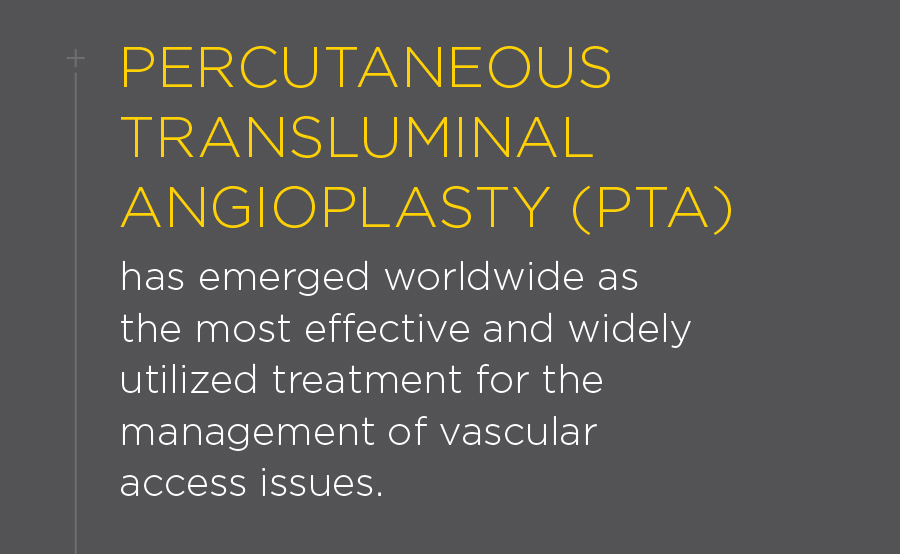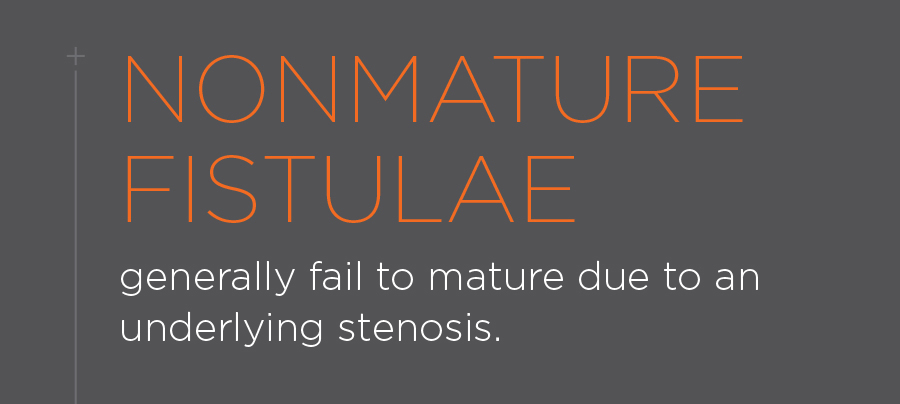PERCUTANEOUS TRANSLUMINAL ANGIOPLASTY CLINICAL PATHWAY SUMMARY
The treatment of stenosis is fundamental to the repair of most dysfunctional hemodialysis vascular access issues. Decades ago, debate focused on surgical revision versus percutaneous transluminal angioplasty (PTA) as the best treatment for access stenosis. PTA has emerged worldwide as the most effective and widely utilized treatment. Technological advancements— including accessibility to fluoroscopy and ultrasound, as well as improvements in balloon catheters and ancillary improvements in stent and stent-graft capabilities—have made PTA the mainstay of therapy, with surgical revision of stenosis a secondary alternative.
PTA has become the first-line therapy because of its ease of access, preservation of venous real estate, low complication rate, low infection rate, immediate recovery of flow, and avoidance of general anesthesia, among other benefits. In many circumstances, PTA can be used to intervene in a dysfunctional access prior to thrombosis and may delay access loss.1 The primary drawback of PTA is the relatively low primary patency rate, which necessitates repeat interventions in order to manage chronic regrowth of intimal hyperplasia.

The timing of interventions, which result in optimal access function and prolong the useful life of a vascular access (VA), is yet to be determined. Both Kidney Disease Outcomes Quality Initiative (KDOQI) and CMS conditions for coverage for ESRD facilities have mandated monitoring by physical examination and surveillance as an integral part of VA care.2,3 Since these mandates were established, there have been remarkable changes in the access landscape. This includes a national proliferation of outpatient vascular access centers, which in one analysis demonstrated significantly fewer vascular access-related infections, fewer septicemia-related hospitalizations, and a lower mortality rate compared to patients treated in hospital outpatient departments.4
Figure 1 | United States AVF Rates by 2014

Since the KDOQI guidelines were first published as the Dialysis Outcomes Quality Initiative (DOQI) recommendations in 1997, access care has changed significantly. For instance, the use of expanded polytetrafluoroethylene (ePTFE) stent grafts, to enhance angioplasty primary patency outcomes, and the use of early stick grafts as a catheter avoidance strategy have emerged. Additionally, dialysis blood pump speed rates rarely exceeded 350cc/min, and guidelines for access intervention recommended waiting until AVF blood flow was less than 400-500 mL/min for AVF and less than 600 mL/min for arteriovenous grafts (AVGs) before referral for diagnosis and intervention.3 Today blood pump flow rates of 450-500 mL/min are expected; waiting until the recommended threshold implies the access may already be dysfunctional.
Although the optimal access flow rate remains unclear, it is known that percutaneous access interventions are effective treatments for failing accesses, and timely interventions will delay episodes of thrombosis and will avoid hospitalizations.6 While the optimal interval of interventions is patient-specific, preemptive interventions as scheduled by monitoring and surveillance techniques have been demonstrated to decrease costly thrombosis episodes.
More sophisticated programs targeting treatment of stenosis at higher flow rates have been shown in some hands to prolong the useful life of an access.1 The goal is to detect and treat clinically relevant stenosis before the patient experiences access failure resulting in missed dialysis treatments and unwanted catheter exposure. Surveillance and monitoring techniques are powerful tools to avoid access complications and are justifications for PTA treatment of stenosis.
Clinical Justifications for AVF and AVG Treatment
Vascular Access Dysfunction
- Changes in bruit/thrill
- Difficulty in cannulation
- Inability to achieve prescribed blood flow rate
- Prolonged bleeding post-dialysis
- Fluctuations in typical arterial and venous pressure readings
- Swelling of the access extremity
- Pain in the access and/or extremity
- Nonmaturing AVF
- Chest wall collaterals
- Ulcer formation
- Development of or changes in aneurysms/pseudoaneurysms
Each of the above is an indication of access dysfunction that is usually caused by an underlying stenosis. Treated preemptively, PTA of the associated stenosis can enhance dialysis efficiency and avoid thrombosis. Stenotic lesions can occur anywhere within the AVF or AVG circuit. Nearly all of these stenoses are treatable with PTA.3
Extremity Edema
KDOQI states that patients with an AVG or AVF who experience edema of the extremity should undergo an imaging study to evaluate patency of the central veins. If central vein stenosis is found, PTA is the recommended treatment. In the event of acute elastic recoil of the vein (less than 50 percent stenosis) after PTA, or if the stenosis reoccurs within three months, stent placement should be considered.3

Access-Relates Steal Syndrome
KDOQI recommends regular assessment for possible ischemia, as part of the monitoring/surveillance program. Physiological steal syndrome occurs in 73 percent of patients with an AVF and 91 percent of patients with an AVG.7
Although generally well tolerated, this may become symptomatic and result in steal syndrome in up to 20 percent of hemodialysis patients.7-12 Early recognition allows for a timely initiation of treatment to prevent potential tissue loss. If the symptoms are mild, wearing a glove on the involved hand and continuing monitoring via thorough physical exam and assessment are often sufficient.
When symptoms are more severe, endovascular and/or surgical interventions may become necessary. In cases of severe steal, with tissue loss, immediate ligation or physiological restoration of blood flow is imperative.13 When an arterial stenosis is the primary cause, PTA is the preferred route and has been shown to be safe and effective.9,14 Percutaneous treatment of any underlying arterial lesions prior to considering surgery may resolve the symptoms and concurrently avoid compromise of the VA.14-17 Beyond inflow stenosis, steal syndrome is treated with procedures that increase inflow resistance, including distal revascularization and interval ligation (DRIL)18 as inpatients, and MILLER- banding as outpatients.16,17
Thrombosis
There have been a number of endovascular techniques used to treat a thrombosed AVF and AVG.19-25 Most of these techniques include treatment of stenosis as an integral part of the thrombectomy process.
Early Interventions for AVF
Nonmature fistulae generally fail to mature due to an underlying stenosis in the feeding artery, at the arterial anastomosis, in the outflow vein, or a combination of issues. Angioplasty is indicated to treat these stenoses and promote maturation.
Aneurysms of AVF
An aneurysm of an AVF is an area of bulging dilatation in the body of the AVF that involves all layers of the wall of the vessel. A stable aneurysm can be left alone, as long as it is monitored. Any changes revealed during physical examination of the aneurysm should be evaluated, and any underlying stenosis should be repaired. Treatment of an aneurysm may be surgical, endovascular, or a combination of the two.26 Since this abnormality is so closely associated with venous stenosis, PTA is frequently the first line of therapy.
AVG Pseudoaneurysm
The following are indicators of potential graft rupture that should be evaluated urgently:
- Poor eschar formation
- Spontaneous bleeding
- Rapid expansion in the size of a pseudoaneurysm
- Severe degenerative changes in the graft material
Patients with pseudoaneurysms should be evaluated for outflow stenosis as soon as possible, and if confirmed, the outflow lesion should be treated by PTA or surgery. While the treatment of the pseudoaneurysm per se is handled most effectively by surgical techniques, there are situations where stent grafts may be utilized.27,28
PTA has become the first line therapy for dialysis vascular access dysfunction. By treating a host of conditions, PTA plays a vital role in maintaining optimal dialysis access function in the fragile ESRD population.

Meet the Expert
Murat Sor, MD
Chief Medical Officer, Azura Vascular Care
FMCNA Corporate Medical Advisory Board Member
A graduate of the University of Pennsylvania, Dr. Murat Sor is certified by the American Board of Radiology, with subspecialty certification in interventional radiology. He is an assistant professor at Georgetown University Hospital’s Interventional Radiology Fellowship program and an adjunct instructor at the George Washington University School of Medicine.
References
Percutaneous Transluminal Angioplasty Clinical Pathway Summary
by Murat Sor, MD
- Tessitore N, Bedogna V, Poli A, et Should current criteria for detecting and repairing arteriovenous fistula stenosis be reconsidered? Interim analysis of a randomized controlled trial. Nephrol Dial Transplant. 2014;29(1):179-187. doi:10.1093/ndt/gft421.
- S. Department of Health and Human Services, Centers for Medicare and Medicaid Services. Conditions for coverage for end-stage renal disease facilities. Title 42, part 494, subpart C: patient care (2010). https://www.cms.gov/Medicare/Provider-Enrollment-and-Certification/GuidanceforLawsAndRegulations/Dialysis.html.
- National Kidney KDOQI clinical practice guidelines and clinical practice recommendations 2006 updates. Am J Kidney Dis. 2006;48(suppl):1-322.
- Dobson A, El-Gamil AM, Shimer MT, et Clinical and economic value of performing dialysis vascular access procedures in a freestanding office-based center as compared with the hospital outpatient department among Medicare ESRD beneficiaries. Semin Dial. 2013;26(5):624-632. doi:10.1111/sdi.12120.
- United States Renal Data 2016 USRDS Annual Data Report: Epidemiology of Kidney Disease in the United States.; 2016.
- Kumbar L, Karim J, Besarab Surveillance and monitoring of dialysis access. Int J Nephrol. 2012;2012:1-9. doi:10.1155/2012/649735.
- Burrows L, Kwun K, Schanzer H, Haimov Haemodynamic dangers of high flow arteriovenous fistulas. Proc Eur Dial Transpl Assoc. 1979;16:686-687.
- Tordoir JHM, Dammers R, van der Sande Upper extremity ischemia and hemodialysis vascular access. Eur J Vasc Endovasc Surg. 2004;27:1-5. doi:10.1016/j.ejvs.2003.10.007.
- Leon C, Asif Arteriovenous access and hand pain: the distal hypoperfusion ischemic syndrome. Clin J Am Soc Nephrol. 2007;2(1):175-183. doi:10.2215/CJN.02230606.
- Haimov M, Baez a, Neff M, Slifkin Complications of arteriovenous fistulas for hemodialysis. Arch Surg. 1975;110(6):708-712. http://www.ncbi.nlm.nih.gov/ pubmed/1147768.
- Kinnaert P, Struyven J, Mathieu J, Vereerstraeten P, Toussaint C, Van Geertruyden Intermittent claudication of the hand after creation of an arteriovenous fistula in the forearm. Am J Surg. 1980;139:838-843. doi:10.1016/0002-9610(80)90393-1.
- Morsy AH, Kulbaski M, Chen C, Isiklar H, Lumsden Incidence and characteristics of patients with hand ischemia after a hemodialysis access procedure. J Surg Res. 1998;74:8- 10. doi:10.1006/jsre.1997.5206.
- Turmel-Rodrigues L, Pengloan J, Rodrigue H, et Treatment of failed native arteriovenous fistulae for hemodialysis by interventional radiology. Kidney Int. 2000;57(3):1124-1140. doi:10.1046/j.1523-1755.2000.00940.x.
- Shatsky JB, Berns JS, Clark TWI, et Single-center experience with the Arrow- Trerotola Percutaneous Thrombectomy Device in the management of thrombosed native dialysis fistulas. J Vasc Interv Radiol. 2005;16(12):1605-1611. doi:10.1097/01. RVI.0000182157.48697.F5.
- Schon D, Mishler Salvage of occluded autologous arteriovenous fistulae. Am J Kidney Dis. 2000;36:804-810. doi:10.1053/ajkd.2000.17671.
- Georgiadis GS, Nikolopoulos E, Papanas N, Mourvati E, Panagoutsos S, Lazarides A Hybrid Approach to Salvage a Failing Long-Standing Autogenous Aneurysmal Fistula in a Hemodialysis Patient. The International journal of artificial organs 33, 819-823 (2010). http://www.ncbi.nlm.nih.gov/pubmed/21140358. Accessed October 6, 2014.
- Fotiadis N, Shawyer A, Namagondlu G, Iyer A, Matson M, Yaqoob Endovascular repair of symptomatic hemodialysis access graft pseudoaneurysms. J Vasc Access. 2014;15(1):5-11. doi:10.5301/jva.5000161.
- Pandolfe LR, Malamis AP, Pierce K, Borge M a. Treatment of hemodialysis graft pseudoaneurysms with stent grafts: institutional experience and review of the Semin Intervent Radiol. 2009;26(2):89-95. doi:10.1055/s-0029-1222451.



